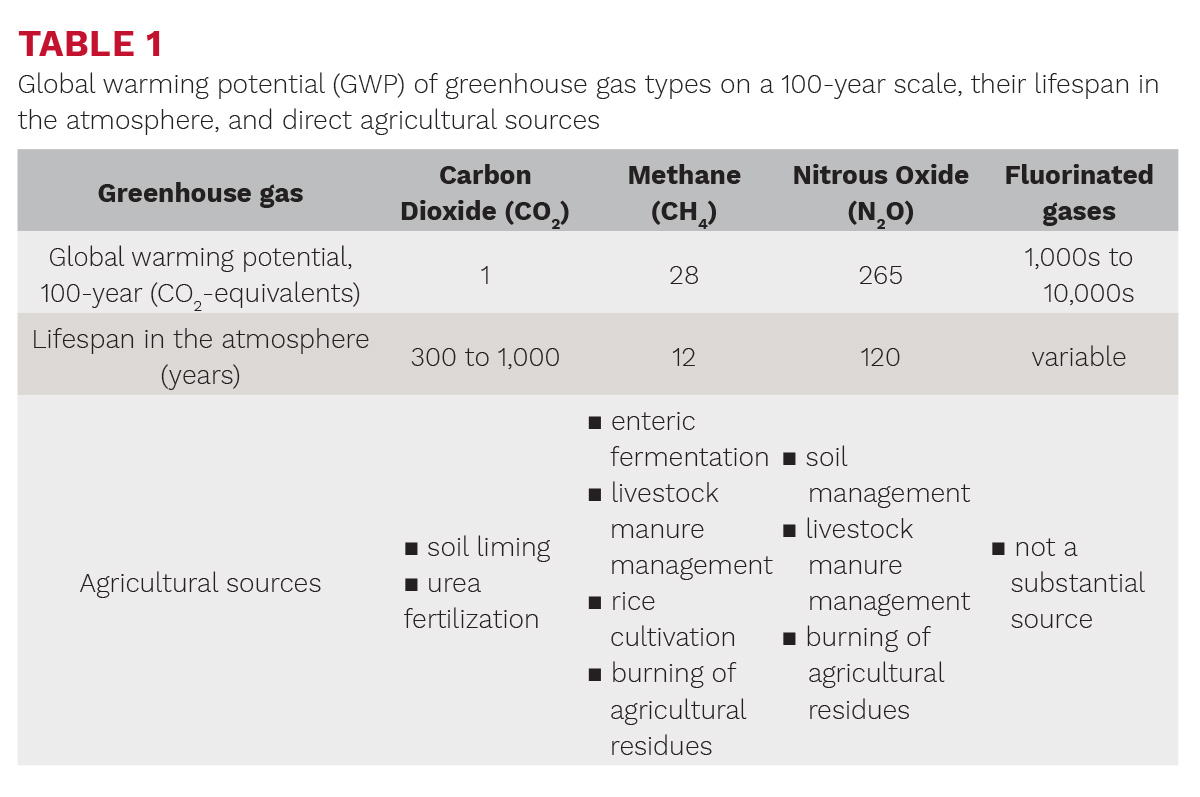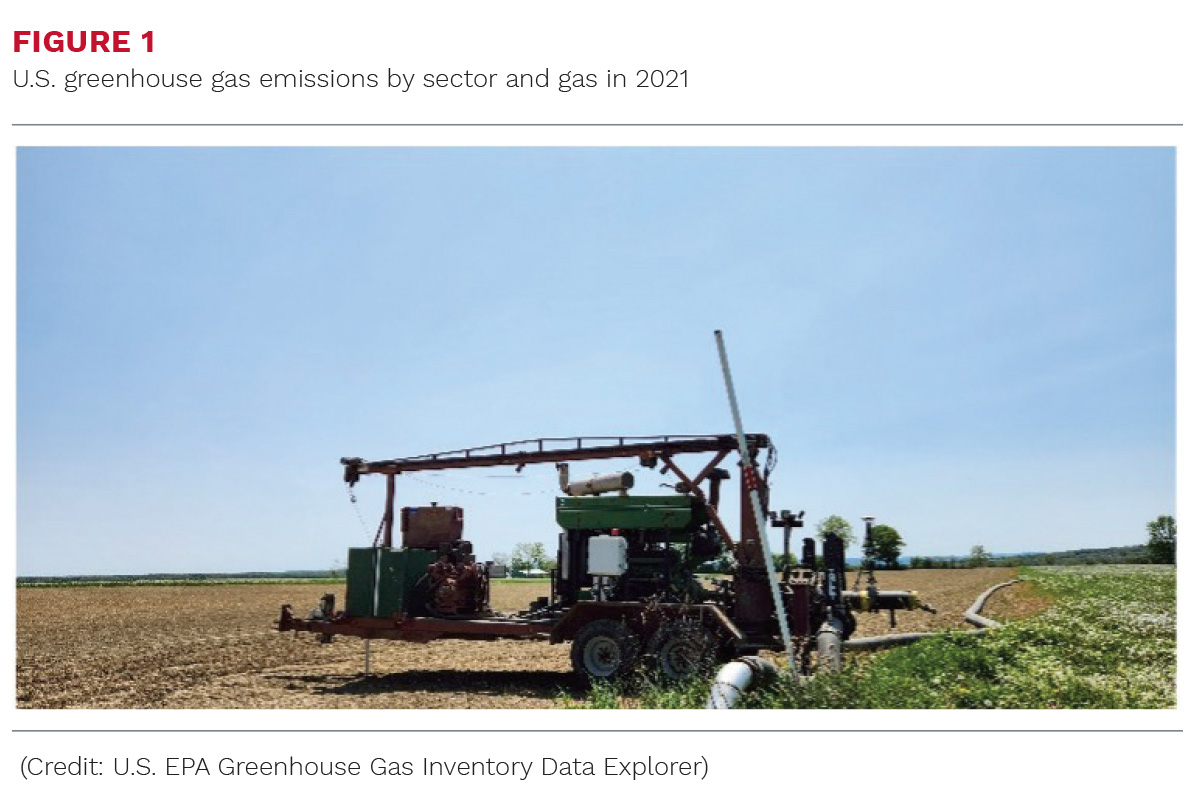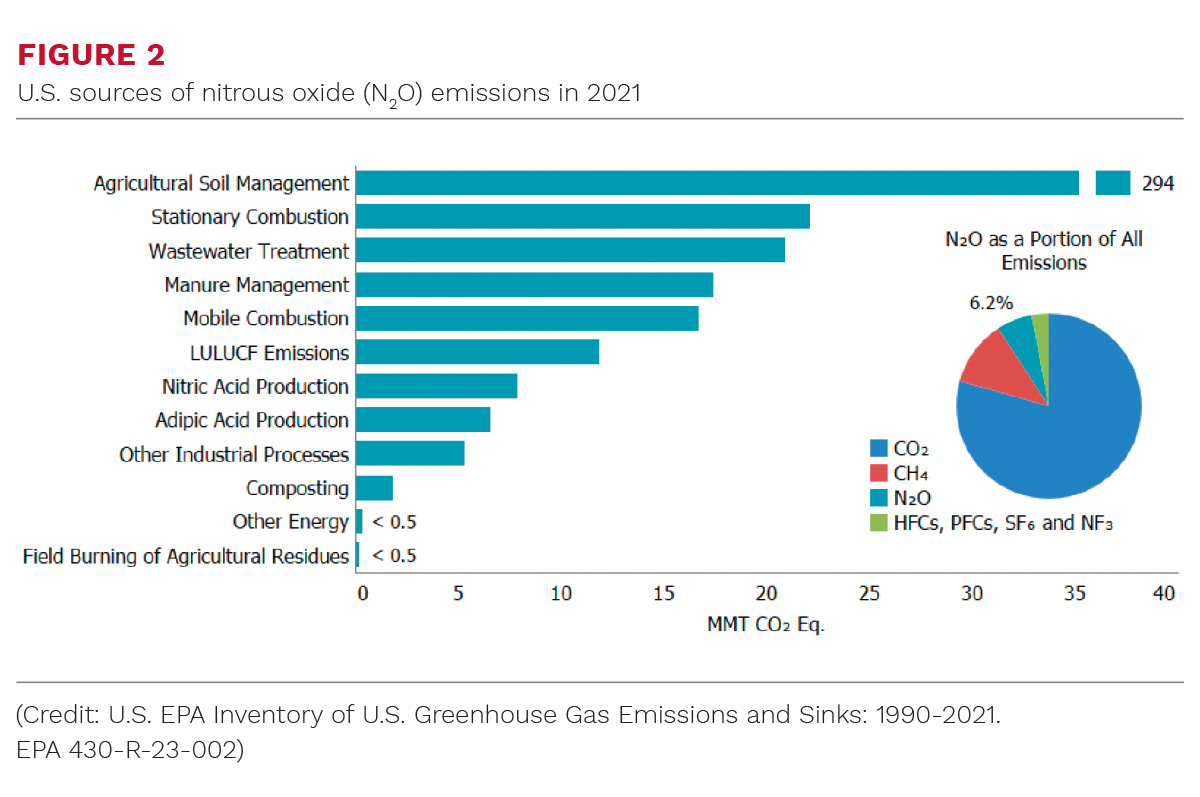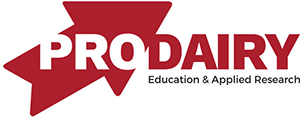Many agricultural activities can directly contribute to the emissions of greenhouse gases, but what are those greenhouse gases and agriculture’s exact impact? What role does dairy production play? We distill the science and provide the facts about U.S. dairy and greenhouse gas emissions.
UNDERSTANDING GREENHOUSE GASES
Four important greenhouse gases (GHGs) contribute to excess warming of the earth’s atmosphere by trapping heat (Table 1). Greenhouse gas (GHG) inventories use the respective global warming potential (GWP) of each gas to put them in terms of carbon dioxide equivalents (CO2e) by setting the GWP of CO2 to one. Their lifespans in the atmosphere also vary widely, with methane (CH4) having a far shorter life (12 years) than the other primary GHGs (Table 1).
In fact, CH4’s warming potential increases to 84 when evaluated over a 20-year scale, as has been adopted under New York State’s climate policy. For this reason, mitigating CH4 can have near-term impacts on climate, while the benefits of reducing other GHGs will not be realized for a century or more. Recognizing this, the U.S. has established a targeted Methane Emissions Reduction Action Plan to reduce this “short-lived climate forcer” substantially by 2030 through new rules for the oil and gas sector and landfills, and through initiation of an incentive-based “climate-smart” agriculture program administered by the USDA. The U.S. dairy industry is aligned in this goal and is committed to GHG neutrality by the year 2050.

U.S. AGRICULTURE AND GHG EMISSIONS
Agriculture sector activities made up 10 percent of all U.S. GHG emissions in 2021, according to the U.S. Environmental Protection Agency (Figure 1).

On a CO2e basis, just over half (52 percent) are nitrous oxide (N2O) emissions, 46.5 percent are CH4, and less than two percent are CO2, exclusive of electricity use. Agricultural soil management accounts for approximately 75 percent of all U.S. N2O emissions and nearly all of the agricultural N2O (Figure 2).

Methane from agriculture makes up 38 percent of all U.S. CH4 emissions, or 5.5 percent of total U.S. GHG emissions. Importantly, 2021 CH4 emissions compared to 1990 levels were 11.9 percent higher from enteric fermentation and 69.2 percent higher from manure management overall, with a 124.3 percent increase attributed specifically to dairy cattle manure management. As other sectors of the economy that emit mainly CO2 from the use of fossil fuels implement technologies to reduce GHG, the agriculture sector contribution is on track to make up a larger portion of the total if these trends continue. Practices and technologies that reduce GHG throughout agriculture and the dairy sector are critical to the sustainability and resiliency of producers and processors.
DAIRY SECTOR GHG BREAKDOWN
The U.S. dairy industry currently accounts for about two percent of total U.S. GHG emissions. Methane from dairy cattle enteric fermentation is the leading GHG from the dairy sector, both in total emissions and per unit of energy-corrected milk (ECM) produced. Manure management is a close second. About 25 percent of CH4 from enteric fermentation is from dairy cattle, and just over 70 percent is from beef cattle. About 50 percent of manure management GHGs are from the dairy sector (predominantly CH4 but including N2O).
According to the Innovation Center for U.S. Dairy, in the cradle-to-farmgate system, the GHG breakdown of U.S. dairy farms has averaged around 35 percent enteric CH4, 33 percent manure management GHG (CH4 and N2O), 26 percent feed production, and six percent energy usage. Gains in milk production have exceeded the rise in GHG emissions from the U.S. dairy industry, resulting in a net decline of GHG per unit of milk produced. From 2007 to 2017, GHG per unit of ECM from U.S. dairy production decreased by 19 percent, according to the Journal of Animal Science’s 2020 publication by Judith L. Capper and Roger A. Cady. These gains in efficiency are important to enhance with practices that can cut total sector CH4 and N2O and reach the U.S. dairy industry GHG neutrality by 2050 commitment.
WHERE TO START?
Given the clear increases in CH4 emissions from both enteric fermentation and manure management, and due to CH4’s short-lived warming potency, it makes sense to start there. Methane reduction practices are the most commercially available and defined for manure management, specifically for alternatives to the long-term open storage of raw, untreated liquid or slurry manure that produces substantial CH4. The rate of CH4 emission from stored manure increases with higher temperatures.
Manure management practices to evaluate include:
- utilizing solid manure storage systems
- reducing liquid storage in the warmer season
- separating manure solids before liquid storage
- utilizing a manure storage impermeable cover and flare system
- implementing manure anaerobic digestion
Enteric methane reduction strategies involving feed additives are still largely under research and development, though are anticipated to advance in this decade and offer a substantial CH4 reduction opportunity. Practical strategies to reduce N2O and improve carbon sequestration can also be implemented that may result in both carbon market revenue and reduced expenses for the farm. Most N2O emissions from agriculture are from growing crops, primarily related to the application (and associated losses) of fertilizers and manure or other soil amendments.
For dairy farms, field and cropping best practices should focus on:
- avoiding over-fertilization through both basic and precision nutrient management
- utilizing enhanced-efficiency fertilizer technology
- maximizing nitrogen retention from manure and reducing nitrogen fertilizer applications
- reducing tillage, cover cropping, and maximizing yields with the least inputs on every farm acre
TO LEARN MORE
- Cornell CALS PRO-DAIRY
- Cornell University Nutrient Management Spear Program
- Inventory of U.S. greenhouse gas emissions and sinks
- U.S. methane emissions reduction action plan
- U.S. dairy net zero initiative
 |
This article appeared in PRO-DAIRY's The Manager in November 2023. To learn more about Cornell CALS PRO-DAIRY, visit PRO-DAIRY. |




